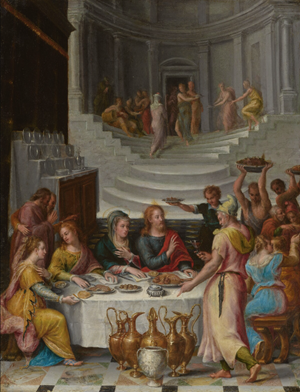
Lavinia Fontana, a prolific painter, created more than 130 known paintings and over 30 drawings from the mid-1570s until her death in 1614. painting and preparatory drawing are the Museum’s first acquisitions by the accomplished Italian artist.
Lavinia Fontana, a prolific painter, created more than 130 known paintings and over 30 drawings from the mid-1570s until her death in 1614.
Now, two of these, a small painting on copper and a preparatory drawing for it, have come to Getty. Together, the artworks provide insight into the artist’s creative process.
A small painting on copper, Fontana’s The Wedding Feast at Cana was acquired earlier this year and marked the first work by the artist to enter Getty’s collection. The preparatory drawing was recently acquired.
Both works depict an episode from the Gospel of John (2:1-11) in which Jesus, his mother Mary, and his disciples are invited to a wedding. When Mary notices that the wine has run out, Christ delivers a sign of his divinity by turning water into wine at her request. Fontana depicted this miracle occurring amid a lively and sumptuous feast.
“Famous for her portraits and altarpieces, Lavinia Fontana was also celebrated for her small, refined, and jewel-like paintings on copper of both religious and secular themes,” says Davide Gasparotto, senior curator of paintings at the Getty Museum. “To create The Wedding Feast at Cana, she painstakingly applied the paint in thin layers and added rich glazes, resulting in a polished, luminous, and highly detailed composition. Her work is an important representative of the late Maniera, a style characterized by elegant refinement and sophisticated palette.”
“These acquisitions provide insight into Lavinia Fontana’s early training and development,” says Julian Brooks, senior curator of drawings at the Getty Museum. “For example, the drawing demonstrates her close relationship to her artist father Prospero Fontana and his friend the Florentine painter Giorgio Vasari. The composition is clearly developed from a drawing by Vasari of the same subject which she adapted from a lunette shape to vertical. It also contains a credenza and two vessels that Fontana added from a drawing by her father which is now in the British Museum.”
Fontana was trained by her father Prospero Fontana, a prominent local painter in Bologna, and married Gian Paolo Zappi with whom she had 11 children. Zappi, who was also an artist trained by Fontana’s father, eventually became her art dealer.
Early in her career, she established herself as a popular portraitist, patronized first by university scholars and then by the local nobility, with a growing clientele of women. She also painted many small, private devotional pictures, as well as mythological works, and several large altarpieces. Fontana’s portraits reflected a traditional specialization for female artists at the time, but her work as a religious painter was unprecedented.
Many of her private devotional works, such as the recent acquisition, are unconventional in their use of a copper support, a choice perhaps influenced by the Flemish painter Denys Calvaert, also a student of Fontana’s father, and the first artist to paint on copper in Bologna.
Throughout her lifetime, Fontana produced the largest surviving body of work by a woman artist active before 1700. She was also the first female artist to achieve professional success outside a convent or a court, the first woman to be accepted into the prestigious Accademia di San Luca in Rome, the first woman to paint large-scale public altarpieces and female nudes, and the first documented female artist to have her own workshop.
The painting and drawing will be on view at the Getty Center in late January 2023, before appearing in an exhibition dedicated to Lavinia Fontana at the National Gallery of Ireland, Dublin, in May 2023.

ArtDependence Magazine is an international magazine covering all spheres of contemporary art, as well as modern and classical art.
ArtDependence features the latest art news, highlighting interviews with today’s most influential artists, galleries, curators, collectors, fair directors and individuals at the axis of the arts.
The magazine also covers series of articles and reviews on critical art events, new publications and other foremost happenings in the art world.
If you would like to submit events or editorial content to ArtDependence Magazine, please feel free to reach the magazine via the contact page.